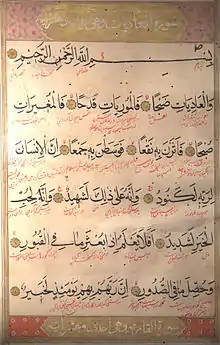Al-Adiyat
The War Horses which run swiftly [1] (Arabic: العاديات, al-ʿādiyāt, aka "The Courser, The Chargers") is the 100th chapter (sūrah) of the Qur'an with 11 verses (āyāt). Regarding the timing and contextual background of the supposed revelation (asbāb al-nuzūl), it is an earlier "Meccan surah", which means it is believed to have been revealed in Mecca, instead of later in Medina.
| سورة العاديا Sūrat Al-ʿĀdiyāt The Coursers | |
|---|---|
| Classification | Meccan |
| Other names | The Chargers, The Assaulters |
| Position | Juzʼ 30 |
| No. of verses | 11 |
| Quran |
|---|
 |
|

Summary
- 1-6 Oaths that man is ungrateful to his God
- 7-8 Man loves the things of this world
- 9-11 Man’s secret thoughts shall be discovered in the judgment-day [2]
A one liner theme of surah al-adiyat would read that this surah gives an example that horses are more grateful to their owners than men are to their Rabb (Allah).[3]
- First five ayaat of the surah consist of an oath as a metaphor enforcing the lesson.[4] They describe a scene of horses charging, panting, producing sparks by their hooves, raiding at the time of dawn, stirring up the cloud of dust and arriving a gathering.
- The substantive proposition is in verses 6-8 that Man is ungrateful to his Lord and himself is a witness to it and he is immoderate in the love of worldly good.[5]
- The last three ayaat conclude the surah with a rhetorical question that Does the man not know about the time when contents of the graves will be resurrected and that which is in men's breasts shall be brought to light on that Day their Sustainer will show that He has always been fully aware of them.
Text
Text and transliteration
بِسْمِ ٱللَّهِ ٱلرَّحْمَٰنِ ٱلرَّحِيمِ
Bismi l-lāhi r-ramāni r-raīm(i)
وَٱلْعَٰدِيَٰتِ ضَبْحًا
1 Wal‘ādiyāti ḍabḥā(n)
فَٱلْمُورِيَٰتِ قَدْحًا
2 Falmūriyāti qadḥā(n)
فَٱلْمُغِيرَٰتِ صُبْحًا
3 Falmughīrāti ṣubḥā(n)
فَأَثَرْنَ بِهِۦ نَقْعًا
4 Fa’atharna bihī naq‘ā(n)
فَوَسَطْنَ بِهِۦ جَمْعًا
5 Fawasaṭna bihī jam‘ā(n)
إِنَّ ٱلْإِنسَٰنَ لِرَبِّهِۦ لَكَنُودٌ
6 ’inna l-’insāna lirabbihī lakanūd(un)
وَإِنَّهُۥ عَلَىٰ ذَٰلِكَ لَشَهِيدٌ
7 Wa’innahū ‘alā dhālika lashahīd(un)
وَإِنَّهُۥ لِحُبِّ ٱلْخَيْرِ لَشَدِيدٌ
8 Wainnahū liḥubbi l-khayri lashadīd(un)
أَفَلَا يَعْلَمُ إِذَا بُعْثِرَ مَا فِى ٱلْقُبُورِ
9 ’afalā ya‘lamu ’idhā bu‘thira mā fi l-qubūr(i)
وَحُصِّلَ مَا فِى ٱلصُّدُورِ
10 Waḥuṣṣila mā fi ṣ-ṣudūr(i)
إِنَّ رَبَّهُم بِهِمْ يَوْمَئِذٍ لَّخَبِيرٌۢ
11 ’inna rabbahum bihim yawma’idhi l-lakhabīr(un)
Name of the surah
Hamiduddin Farahi is a celebrated Islamic scholar of Indian subcontinent is known for his groundbreaking work on the concept of Nazm, or Coherence, in the Quran. He writes that Some sūrahs have been given names after some conspicuous words used in them.[6] Jalaluddin Al-Suyuti co-author of the classical Sunni tafsīr known as Tafsir al-Jalalayn d after the word Adiyat with which it opens.
Period of revelation
Surahs in the Qur'an are not arranged in the chronological order of revelation[7] because the order of the wahy or chronological order of revelation is not a textual part of the Quran. Muhammad told his followers sahaba the placement in Quranic order of every Wahy revealed along with the original text of Quran.[8] Wm Theodore de Bary, an East Asian studies expert, describes that "The final process of collection and codification of the Quran text was guided by one over-arching principle: God's words must not in any way be distorted or sullied by human intervention. For this reason, no serious attempt, apparently, was made to edit the numerous revelations, organize them into thematic units, or present them in chronological order....".[9][10] The manuscript, or version, of the Quran we see today was compiled by Uthman, the third caliph (reign 644 to 656); a caliph being the political leader of a Caliphate (Islamic government).Before Uthman canonized the Quran there were different versions or codices, none of which exist today. These codices never gained general approval and were viewed by Muslims as the personal copies of individuals.[11] However, "the search for variants in the partial versions extant before the Caliph Uthman's alleged recension in the 640s has not yielded any differences of great significance".[12] Whether this Surah Al-Adiyat is a Makki or a Madani is disputed. But the subject matter of the Surah and its style clearly indicate that it is not only Makki, but was revealed in the early stage of Makkan period.[3] Abdullah bin Masud, Jabir, Hasan Basri, Ikrimah, and Ata say that it is Makki. Anas bin Malik, and Qatadah say that it is Madani; and from Ibn Abbas two views have been reported, first that it is a Makki Surah, and second that it is Madani. But the subject matter of the Surah and its style clearly indicate that it is not only Makki but was revealed in the earliest stage of Makkah. So the surah is considered to be Meccan conclusively.[13]
Hadith
According to hadith this surah is recommended in Maghrib prayer.
- Hisham ibn Urwah said that his father used to recite the surahs like the Al-Adiyat is recited. Abu Dawud said: This indicates that those (traditions indicating long surahs) are abrogated, and this is more sound tradition.[14]
References
- George Sale translation
- Wherry, Elwood Morris (1896). A Complete Index to Sale's Text, Preliminary Discourse, and Notes. London: Kegan Paul, Trench, Trubner, and Co.
 This article incorporates text from this source, which is in the public domain.
This article incorporates text from this source, which is in the public domain. - Source: Malik Al-Qur'an Translation Translator: Muhammad Farooq-i-Azam Malik Edition: First, Hardback Published: 1997 Publisher: The Institute of Islamic Knowledge, Houston, Texas, USA
- Source: Yusuf Ali Al-Qur'an Translation Edition: First, Hardback Publisher: Kingdom of Saudi Arabia
- Mohammed, A Comprehensive Commentary on the Quran: Comprising Sale’s Translation and preliminary Discourse, with Additional Notes and Emendations (London: Kegan Paul, Trench, Trubner, and Co., 1896). 4 vols.
- "Archived copy" (PDF). Archived from the original (PDF) on 2010-06-13. Retrieved 2009-10-04.CS1 maint: archived copy as title (link)
- Robinson, Neal (2003). Discovering the Qur'an: A Contemporary Approach to a Veiled Text (PDF). Georgetown University Press. pp. 25–97. ISBN 1589010248.
- Israr Ahmed – Bayan-ul-Quran – Introduction
- Approaches to the Asian Classics, Irene Bloom, Wm Theodore de Bary, Columbia University Press, 1990, p. 65 ISBN 9780231070058
- Eastern Canons.
- Esack, Farid (2005). The Qur'an: A User's Guide. Oxford England: Oneworld Publications. ISBN 978-1851683543.
- F. E. Peters, The Quest of the Historical Muhammad, International Journal of Middle East Studies, Vol. 23, No. 3 (Aug.,1991), p. 293
- "Archived copy". Archived from the original on 2018-01-13. Retrieved 2016-12-10.CS1 maint: archived copy as title (link)
- Sunan Abu Dawud 813 In-book reference : Book 2, Hadith 423 English translation : Book 2, Hadith 812